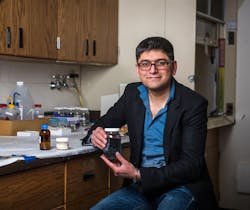Workable Liquid Polymer Leads to Lightweight Ceramics, Semiconductors
A clear liquid polymer invented at Kansas State University may be the most versatile ceramic precursor of its kind. When designing a boron-modified silazane polymer, Gurpreet Singh, Romil Bhandavat, and other associate professors in nuclear and mechanical engineering considered its optical, electrical, and heat conductive properties, and tested it in combination with organic materials to change its electrical conductivity. The recently patented formula is highlighted for practicality in handling and production for applications in energy, aerospace, defense, electronics, and other industries.
The patent describes methods for boron doping in a silizane polymer to a create a liquid precursor to SiBNC ceramics. With a viscosity similar to that of liquid water, the final product can be sprayed, poured, or even 3D printed via stereolithography onto fibrous organic substrates. Heating in a traditional oven or with microwaves leads to dark ceramics that can applied as hard, lightweight coatings on turbine blades, or even on clothing requiring heat protection.
The boron enables binding with organic fibers, including those that change electrical conductivity. Dispersion of carbon nanotubes (CNTs), fullerenes, and other nanofillers within the ceramic matrix results in nanocomposites with tunable semiconductor properties. Therefore, the invention could be useful in new electronics, piezoelectronics, thin-film sensors, and other applications. The team experimented with different nanofiller species and concentrations, and used Raman spectroscopy and transmission electron microscopy to measure binding and optical effects.
Adding monowalled CNTs to the polymer also changed the optical properties of the resulting nanocomposites. After curing, the nanocomposites were very dark, and absorbed ultra-violet light without warping or peeling. Heat resistance was also boosted to 15,000 watts per square centimeter--about 10 times greater than heat experienced by rocket nozzles.
The patent also describes other workable form factors for the ceramic precursor. For example, at temperatures between 50 and 100 degrees Celsius, the polymer's viscosity increases so that it can be stretched and hardened into ceramic strands.
The material can survive a month in an open container, which is longer than most boron-modified silazane polymers. After a month, the polymer cures or the boron separates from the polymer and precipitates to the bottom of the container. Preservation with argon gas prolongs its shelf life.
Because the research was funded by a National Science Foundation grant, some ownership rights are held by the U.S. government.
About the Author
Leah Scully
Associate Content Producer
Leah Scully is a graduate of The College of New Jersey. She has a BS degree in Biomedical Engineering with a mechanical specialization. Leah is responsible for Machine Design’s news items that cover industry trends, research, and applied science and engineering, along with product galleries. Visit her on Facebook, or view her profile on LinkedIn.
